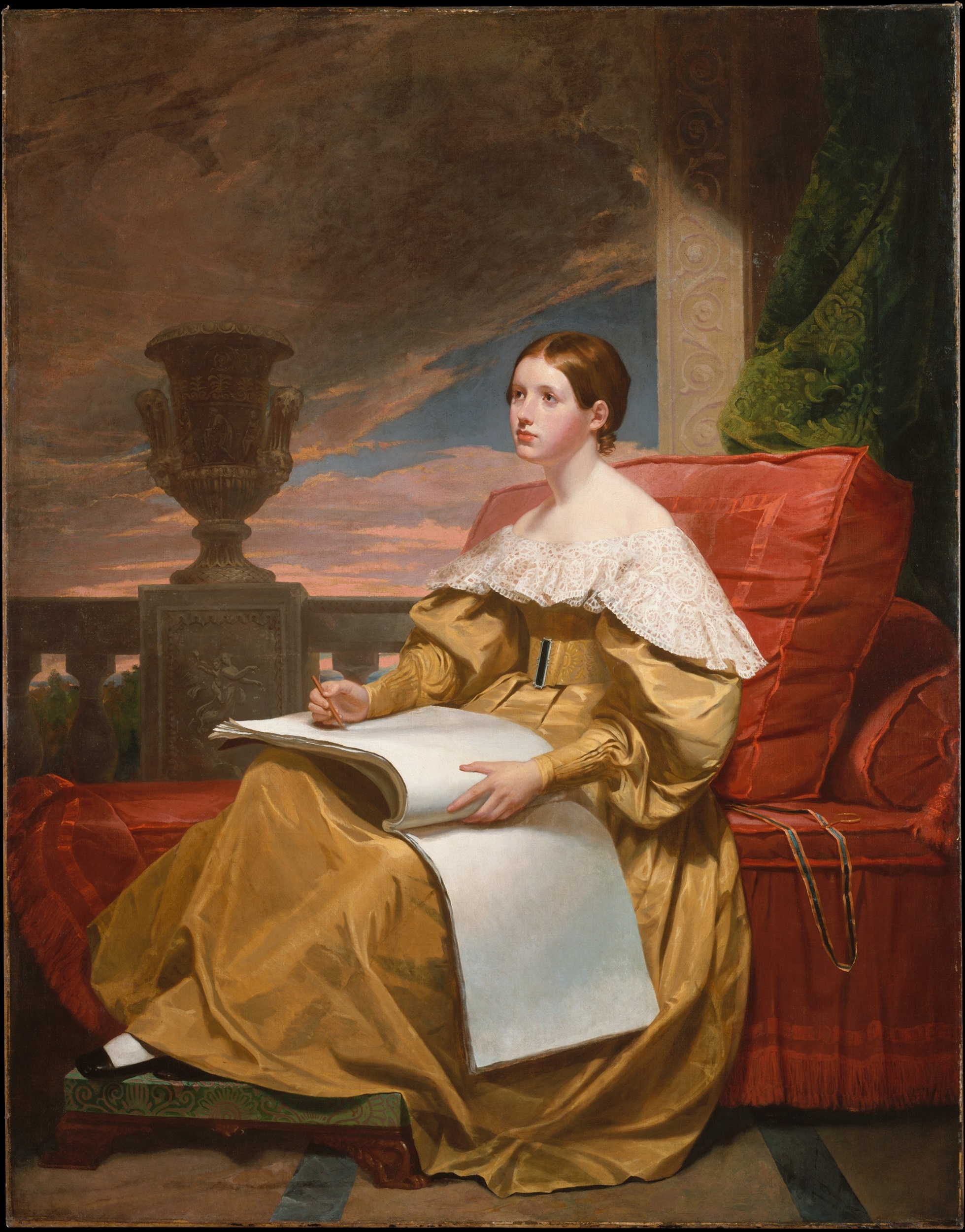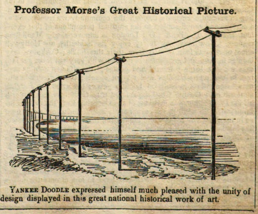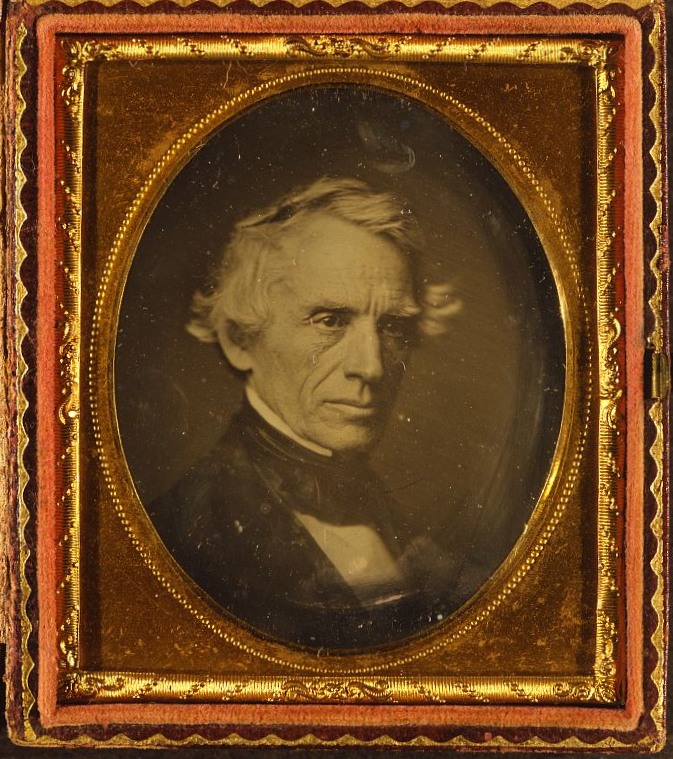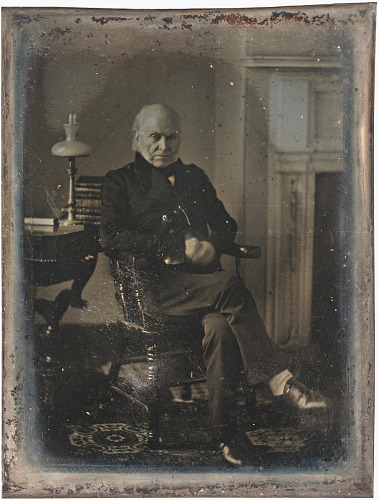Jilted: Samuel F. B. Morse at Art’s End
PDF: Staiti, Jilted
Samuel F. B. Morse’s bitter lament over an art career dead and gone did not arrive until 1849, more than a decade after he had painted his last picture. It came at precisely the same moment he was hearing thunderous applause for inventing an electromagnetic telegraph that had done nothing less than obliterate space and time. Yet, in that cacophony of fame, the memory of a lost art career haunted him like a photo from the wreckage of an old collision.
On one side of the smash-up there was Morse’s irrepressible ambition. While a student at the Royal Academy in London (1811–15), he had already imagined himself poised to not merely “rival the genius of a Raphael, Michael Angelo, or a Titian,” but also “shine the brightest” in the “constellation of genius” rising in America.1 Destiny, he believed, was calling. When, at midcareer, he returned from a three-year trip to Europe in 1832, he believed that the federal government would, without a doubt, invite him to produce a colossal picture to hang in the Capitol Rotunda alongside John Trumbull’s four canvases on scenes from the American Revolution. So smitten by his own importance, he might have even fancied himself being feted one day in the future, as Trumbull was in 1826, by congressional leaders and the president who would gather under the great dome for the unveiling of his picture.
On the other side of the collision, the unmovable object against which Morse propelled himself was the United States of America. He was persistently vexed by its values, offended by its tastes, and disappointed to be painting portraits instead of idealistic subjects, yet he was so determined to impose elite standards on the nation that he despaired over his own failure to live up to his outsized drive to be the country’s avatar of high culture. His two monumental efforts to capture the flag, The House of Representatives (1822–23) and The Gallery of the Louvre (1832–33), spectacularly failed to catch on, and they also confirmed that Morse was not about to rival the genius of Raphael.
Those oppositional forces, long since on a fatal course with the artist, came to blows in 1837 when Morse was, in fact, under congressional consideration for one of the four remaining Rotunda commissions that he so coveted. His case was legitimate: professional artist for twenty-five years, founder and president of the National Academy of Design in New York City, author and lecturer on art theory, leading voice of the fine arts in America, and Professor of Fine Arts at New York University. Surely, he was the equal of the other artists under review: Thomas Sully, John Vanderlyn, Henry Inman, Rembrandt Peale, John Gadsby Chapman, and Washington Allston.
The path forward for Morse and the others was made difficult by John Quincy Adams, congressman and former president, who chaired the “Joint Committee for furnishing the Rotundo.”2 Adams was potentially problematic because he had spent decades imbibing Old Master art while an American diplomat in Europe. In the role of committee chair for the Rotunda commissions, he actually stood up in the House of Representatives in 1836 and threatened to hire foreign artists to execute the paintings because he thought US artists were so inferior. Never one to mince words, Adams noted in his diary, with disgust, that in the United States “mediocrity shelters itself under the dignity of Art; and thus it is that works at the cost of a Nation settle into patronage jobs.”3 He exempted Allston from his blanket dismissal, but surely his threat to look abroad infuriated Morse, a bull-headed nationalist then presiding over the National Academy.
Even Adams would have to admit that Morse was a highly credentialed contender for the commission, yet it was obvious that his candidacy was also deeply flawed. Looked at from a political point of view, Morse had already disqualified himself from the job. Unlike his contemporaries in the arts, he rejected the unstated rule of outward nonpartisanship by plunging himself headlong into the most controversial political issues of the day, making him radioactive to a US Congress that was to be his employer. It was impossible for the joint congressional committee, as well as Congress at large, to overlook his political positions. Morse dreaded the egalitarian turn in US politics, feared the end of slavery would be “rife with danger to our country,” saw Catholic immigrants as a “vicious, ignorant” threat to the union, and ran for mayor of New York on a nativist ticket.4 He imagined the pope in Rome arming his minions with an eye to overtaking the United States; wrote a book professing to tell the true tale of French Catholic priests who engage in sex orgies, murder, and necrophilia; and published the most ruthless, most influential, and best-argued nativist tracts of the 1830s. “The serpent has already commenced its coil around our limbs,” Morse wrote, as if he were a latter-day Laocoön, “and the lethargy of his poison is creeping over us.”5
Morse was so conservatively extremist that he would earn a place in Richard Hofstadter’s The Paranoid Style in American Politics.6 One New York newspaper in 1836 openly questioned his sanity: “Mr. Morse is a scholar and a gentleman—an able man—an accomplished artist—and we should like on ninety-nine accounts to support him. But the hundredth forbids it. Somehow or other he has got warped in his politics.”7 To congressmen looking for large public paintings that would sing the glories and promote the mythologies of the United States, he was obviously a political hazard fatally misaligned with any traditional sense of what an artist was supposed to be like.
As a result of his political positions and a personal friction with Adams, his 1837 bid to paint for the Rotunda failed.8 Yet, Morse remained clueless: “I regret to learn that Mr. Adams, from some cause wholly unknown to me, should have taken so decided and openly hostile attitude towards me. I never gave him the slightest cause of personal offence, either on political, religious, or any other ground. Yet his opposition (I learn it from the best authority), has been of a character which evinced strong personal animosity.”9 Did Morse not understand that his racist politics were a red flag to Adams, the outspoken abolitionist from Massachusetts? Could he not imagine that turning over a Rotunda commission to a strident nativist might offend some members of the selection committee?
Morse felt “the bitterness of disappointment he [Adams] has caused in my heart.” He “staggered under the blow” of rejection, took to bed “quite ill,” and flirted with thoughts of suicide.10 He wrote in a letter that he believed that the honor had been “snatched from me at the moment when it appeared to be mine beyond a doubt.”11 To Allston, he confessed, “What is better known to you than to any one else the struggles and sacrifices I have made under every disadvantage and discouragement to keep myself prepared for a great work of the kind long held up by the government to lure the artist of ambition to make just such exertions and sacrifices as I have made.”12 James Fenimore Cooper and Thomas Cole tried to rally him out his depression with kind words, but Morse struggled to regain his bearings.
Morse took refuge from the hurt of the 1837 rejection in the form of his experiments with the electromagnetic telegraph, which were absorbing, promising, and potentially lucrative. By the time another Rotunda commission opened up in 1846, his experiments were becoming an empire as telegraph companies were busy stringing lines across the East, patents were being secured in his name, tens of thousands of federal dollars were funding his projects, old patterns of communication were being replaced, and as a result Morse was being hailed as “the nation’s idol!”13 Yet, he still craved that Rotunda commission and wrote that he imagined he could be “restored to my position as an artist by the same power that prostrated me [in 1837].”14 He hung his last great painting, The Muse (1837; fig. 1), in the Rotunda as demonstration of his artistic powers and benefited from a petition, signed by the leading artists and patrons of the arts in New York, begging Congress to select him.15

It came to nothing. That second rejection prompted him to descend into bitter accusations over how he had been betrayed by his own government and how that, in turn, had forced him to give up on any hope of ever standing at the apex of the American art world. Scorned twice by what he saw as an injustice, Morse salted the open wound in a plaintive letter to his understanding friend Cooper: “The very name of pictures produces a sadness of the heart I cannot describe. Painting has been a smiling mistress to many, but she has been a cruel jilt to me. I did not abandon her, she abandoned me.” Perhaps because he was writing to the prolix Cooper, Morse indulgently figured himself as a broken man. He adeptly turned his market failure into a romantic case of unrequited love: “Except for some family portraits valuable to me from their likenesses only,” he continued, melodramatically, “I could wish that every picture I ever painted was destroyed. I have no wish to be remembered as a painter.”16
Morse (fig. 2) again blamed Adams (fig. 3) not only for the rejection but also for the final death knell of his art career. To his brother Richard, he fumed, “He killed me as a painter, and he intended to do it. . . . May God forgive him as I do.”17 Stung by the rebuff and convinced that Adams was motivated by personal vendetta, Morse had found the straw man to whom he could point as his executioner. As his thinking went, because Adams did not, or would not, value him despite his lifelong achievements as a painter and leader of artists, Morse had no choice but to walk away and take his paint brushes with him. Ergo decedo: “Therefore, I quit.” That was his rebuke to Adams’s rebuke and all those he believed had rebuked him in the past.
But, of course, Morse had options, both in 1837 and 1846; he could have decided, at any juncture, to pause technology, resume his once-bustling portraiture business, and continue to fight the good fight for what he believed to be quality art in the United States. Instead, he convinced himself that he had not quit America; America quit him. It was a convenient exit rhetoric that prefigured Richard Nixon’s humiliating—and temporary—retirement from politics in the 1960s. If I substitute names, Morse was, in effect, saying to Adams, Congress, and the nation: “That’s your right. But as I leave you, I want you to know: just think how much you’re going to be missing. You don’t have Morse to kick around anymore.”18
A different perspective on the situation came from the cheeky inaugural issue of the satirical magazine Yankee Doodle, which suggested that in 1846 Morse was not actually being evaluated by Congress for his former artistic credentials at all. Instead, the magazine observed that a group of wealthy “American Maecenases lately united in a petition to Congress that Professor Morse should be rewarded for his invention of the Magnetic Telegraph, by receiving the commission to fill the vacant panel in the Rotunda of the Capital, with an historical picture.”19 Whether or not Yankee Doodle had any evidence to back up that assertion, it was undeniable that by 1846 Morse’s painting skills had withered from disuse, while his technology skills were now his true claim to fame.
Following its impish calculus that one electromagnetic telegraph should equal one Rotunda commission, Yankee Doodle further wondered whether Morse’s tech career actually could have earned him the painting job if the spotty performance of the early telegraph were any measure: “Considering the service he [Morse] rendered, it would be better to make him President of the Board of Brokers [the stock exchange], whose shaving [defrauding] operations he has assisted so much by the hopeless confusion into which Wall-street is thrown by the irregularity of the Telegraphic dispatches, and their bewildering incomprehensibility when they arrive.”20

Never heedful of when to stop, Yankee Doodle proceeded to knock Morse down a few more pegs by mocking all the inaccurate Mexican War dispatches being delivered by his telegraph. Instead of a Rotunda commission, perhaps Congress should name him “Generalissimo of the Army,” since the telegraph’s “Pythonic” (prophetic) code of dots and dashes had issued so much war news bunk “that no one could tell whether we had beaten the Mexicans or they us, until the mail arrived to assist in construing the Magnetic Oracle.”21 For its final blow, the magazine suggested a sarcastic design of telegraph wires for Morse’s never-to-be-realized Rotunda painting (fig. 4).
Exactly how bad should we feel for Morse and the end of his art career? A bit. Technology had already been in competition with painting at the time of the 1837 snub. A year later, his painting career was effectively over. When he walked through the Rotunda in 1838, it was to lobby a deliriously happy Congress and President Martin Van Buren to pay him to engineer a fifty-mile test of the telegraph between Washington, DC, and Baltimore. And that was just the beginning of the flow of federal dollars into his hands. A few months later, the French could see that he was on destiny’s path; at the Institut de France in 1838, Morse would hear the room echo with acclamation: “Extraordinaire! Tres Bien! Tres Admirable!”22 Those were the words he never heard exclaimed in front of The Gallery of the Louvre or any of his other pictures.
By the time of the second rejection in 1846, Morse was almost a decade out of touch with painting. Moreover, in 1844, he had successfully wired those fifty miles between Washington and Baltimore and sensationally transmitted an electronic message: “What hath God wrought.” Given that context, the 1846 decision not to commission Morse to paint for the Rotunda was foregone because he had already moved on from his art career. Waves of acclaim on the international stage washed over him as an inventor, as did financial rewards. Newly married in 1848, he hired A. J. Davis to design Locust Grove, his beautiful summer villa overlooking the Hudson River at Poughkeepsie, while maintaining a townhouse on 22nd Street, near Fifth Avenue, in New York City. Not too shabby a life.
The telegraph was a juggernaut that swept aside whatever crumbs were left of his art career, including his leadership of the National Academy of Design, which he started to neglect and from which he resigned the presidency in 1845. Though he enviously claimed in his “cruel jilt” letter that picture making was a “smiling mistress” to other artists but not to him, Morse should have added that another mistress was drenching him in fame and fortune for the telegraph.
If we speculate for a moment, we might ask what would have happened if Adams and Congress had decided to overlook Morse’s right-wing screeds and hired him to paint for the nation, either in 1837 or 1846. Was there any reasonable expectation that he could have found the time to research, design, and paint one of the twelve-by-eighteen-foot canvases specified for the Rotunda while absorbed with the telegraph? As evidence, consider the group of fellow artists—Thomas Cole, Thomas Sully, Henry Inman, Asher B. Durand, William Dunlap, Robert Weir, William Page, and others—who hoped to buoy Morse after the 1837 rejection by forming a joint stock association that raised the money to pay him to paint the colossal picture, full size, that he had hoped to install in the Capitol.23 A kind gesture, to be sure. But, after years of inaction and questions raised in New York newspapers about the unused money in his hands, Morse was forced to return the funds.
Why had he not pursued the project? As he explained his thinking to his kind benefactors at the outset, “I ought not to conceal from the gentlemen who have so generously formed the association, that circumstances may arise, in relation to the Telegraph, which may make it a paramount duty, to myself and to my country” to suspend painting and to put the telegraph first.24 All his romantic laments to Cooper and others aside, Morse’s departure from art to technology was his own decision and not the tragedy that he, as well as some chroniclers of American art, have made it seem.
In a perfect world, perhaps Morse could have seen his way to thanking Adams—rather than condemning him—for having helped close the door definitively on a very good, but not exceptional, artistic career. Maybe, in denying him a Rotunda commission that would have been a massive distraction, Adams had, in truth, inadvertently accelerated progress on the telegraph by banishing art from Morse’s agenda. And, because a dozen other inventors worldwide were working on electrical signaling and filing patent claims, Adams had also given Morse a gift: the time to get a leg up on his competitors and win the day.
Cite this article: Paul Staiti, “Jilted: Samuel F. B. Morse at Art’s End,” in “Ex-Artists in America,” ed. Oliver O’Donnell, In the Round, Panorama: Journal of the Association of Historians of American Art 10, no. 1 (Spring 2024), https://doi.org/10.24926/24716839.18873.
Notes
- Samuel F. B. Morse to Jedidiah Morse, May 3, 1815, Morse Papers, Library of Congress. ↵
- John Quincy Adams Diary, June 30, 1836, Massachusetts Historical Society, Boston. The joint resolution to form a subcommittee of the Committee on Public Buildings occurred on December 15, 1834. Adams recalled it was to approve “four historical pictures, to fill the four vacant frames in the rotunda the subjects to be selected by the committee in consultation with the artists. I somewhat inconsiderately moved to strike out the word ‘four’; so as to leave it discretionary with the committee to employ fewer artists; observing that if four different persons must be engaged to paint four pictures, there would be danger that a part of the work would not be worthy of the place or of the dignity of the nation. I doubted if four native artists could be found of eminence in the profession so transcendent as to ensure the performance of four masterpieces.” Memoirs of John Quincy Adams: Comprising Portions of His Diary from 1795 to 1848, ed. Charles Francis Adams, 12 vols. (Philadelphia: J. B. Lippincott, 1877), 11:189. In 1837, the voting committee consisted of Adams of Massachusetts, as well as Senator William C. Preston of South Carolina, Senator Garret D. Wall of New Jersey, Senator Silas Wright of New York, Representative Leonard Jarvis of Maine, Representative John McKeon of New York, Representative Henry Johnson of Louisiana, and Representative Benjamin Howard of Maryland. The vote occurred on July 1, 1837. ↵
- Adams, Diary, August 12, 1836. Representative Henry Alexander Wise of Virginia rebutted Adams, announcing that the United States “is richer now in native talents in the fine arts than any country on the globe.” Quoted in Cooper, Letters and Journals of James Fenimore Cooper, ed. James Franklin Beard, 6 vols. (Cambridge: Belknap, 1964), 3:81. ↵
- Morse, quoted in Kenneth Silverman, Lightning Man: The Accursed Life of Samuel F. B. Morse (New York: Knopf, 2003), 141. ↵
- Samuel F. B. Morse, Foreign Conspiracy Against the Liberties of the United States (New York: Leavitt, Lord, 1835), 95. ↵
- Richard Hofstadter, The Paranoid Style in American Politics (New York: Vintage, 1952), 16. See also Silverman, Lightning Man, 132–43; and Paul Staiti, Samuel F. B. Morse (Cambridge: Cambridge University Press, 1990), 207–14. For the inflection point between Morse’s two careers, see Sarah Kate Gillespie, “Morse and ‘Mechanical Imitation,’” in Samuel F. B. Morse’s “Gallery of the Louvre” and the Art of Invention,” ed. Peter John Brownlee (New Haven, CT: Yale University Press, 2014), 100–109. ↵
- New York Commercial Advertiser, April 19, 1836, 5. ↵
- It has also been suggested that part of the problem between the two men came from Adams’s belief that Morse had written critically about him in a New York newspaper; see Carleton Mabee, The American Leonardo: A Life of Samuel F. B. Morse (New York: Knopf, 1943), 186. ↵
- Samuel F. B. Morse to Washington Allston, March 21, 1837, Morse Papers, Library of Congress. ↵
- Cooper, Letters and Journals of James Fenimore Cooper, 3:259. See also Silverman, Lightning Man, 145. ↵
- Samuel F. B. Morse to Edward Salisbury, February 24, 1841, Morse Papers, Library of Congress. ↵
- Samuel F. B. Morse to Washington Allston, March 21, 1837, Morse Papers, Library of Congress. ↵
- Mrs. Henry Ellsworth to Samuel F. B. Morse, quoted in Samuel Irenaeus Prime, The Life of Samuel F. B. Morse (New York: D. Appleton, 1875), 541. ↵
- Samuel F. B. Morse to Sidney Edwards Morse, March 28, 1846, Morse Papers, Library of Congress. ↵
- Mabee, American Leonardo, 294. The petition was signed by Asher B. Durand, Thomas Cummings, Francis Edmonds, Charles Ingham, Jasper Cropsey, Charles Loring Elliott, and James Renwick, among the artists. ↵
- Samuel F. B. Morse to James Fenimore Cooper, November 20, 1849, Morse Papers, Beinecke Library, Yale University. ↵
- Samuel F. B. Morse to Richard Cary Morse, February 24, 1848, Morse Papers, Yale University. ↵
- These lines adapted from the “last press conference” of Richard Nixon from November 7, 1962, following his loss in the 1962 California gubernatorial election. ↵
- “The Fine Arts,” Yankee Doodle 1 (1846/47), 5. ↵
- “The Fine Arts,” 5. ↵
- “The Fine Arts,” 5. ↵
- Undated letter to Alfred Vail, quoted in Prime, The Life of Samuel F. B. Morse, 365. ↵
- Friends of Mr. Morse to Morse, March 17, 1837, Morse Papers, Library of Congress. At twelve by eighteen feet, the subject was to be The Germ of the Republic: The Pilgrim Fathers Signing the First Written Constitution on Board the Mayflower in the Harbor of Cape Cod, November 11, 1620. ↵
- Prime, The Life of Samuel F. B. Morse, 292. ↵
About the Author(s): Paul Staiti is Professor of Fine Arts on the Alumnae Foundation, Department of Art History and Architectural Studies, Mount Holyoke College.



